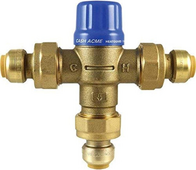I also install a mixing valve when I replace a tank. Set temp high over 140F, and adjust the water temp at the mixer. Doubles effective tank capacity, and removes legionaries disease concerns.
I didn't want to derail the diy thread but this comment got my attention.
Now that we have this place on solar, I'd love to have a hot water preheat tank ... but our system is an instantaneous gas one and it is very handy in that we can dial up a temperature and not have to worry about the cold tap for showers.
This is important here because we care for my wife's mum and being able to dial up a safe temp for her shower is one less thing we have to worry about.
I understand that a preheater needs to be high enough to prevent legionaries disease, but that will make it higher than what we need for MIL.
Can we fit a mixer valve to drop it like you have ... but then still feed it through the instantaneous gas one?
Being preheated should still save on gas ... but keeping the gas unit will retain the safety aspect.
Or is there a better way of going about it? Thanks.



